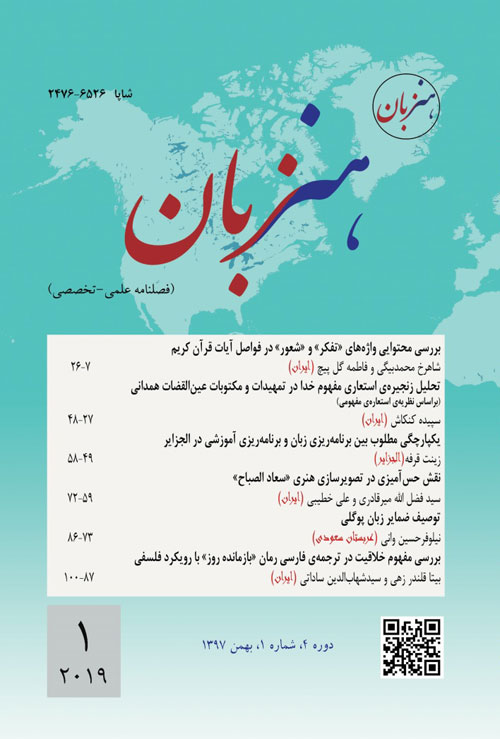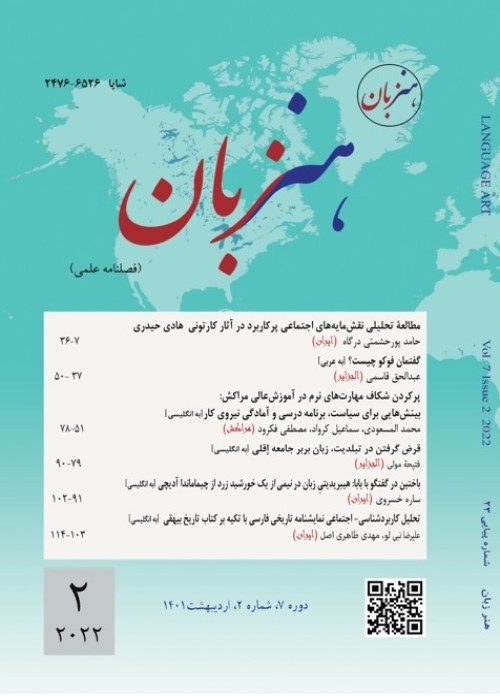فهرست مطالب

نشریه هنر زبان
سال چهارم شماره 1 (بهمن 1397)
- تاریخ انتشار: 1398/01/22
- تعداد عناوین: 6
-
صفحات 7-26هدف بعضی از آیات در بیان نشانه ها، «تفکر» درجهت کشف مقاصد نهایی خلقت است. «شعور» نیز از مباحث مهم قرآنی بوده که آیاتی را در قرآن کریم به خود اختصاص داده است. خداوند متعال بارها در قرآن انسان را به «تفکر»، «تذکر» و «تعقل» دعوت کرده است. افزون براین، حتی در آیاتی «عدم تفکرواندیشیدن» را توبیخ و ملامت کرده است؛ لذا در این پژوهش به بررسی محتوایی آیاتی پرداخته ایم که در فواصل آیات از ریشه ی «فکر» و «شعر» استفاده شده است. این پژوهش به دو فصل تقسیم می شود که فصل اول آن راجع به «تفکر» و فصل دوم آن درباره ی «شعور» است. هرفصل شامل دو بخش است که در آن ها ابتدا واژه ها را ازلحاظ لغوی و سپس ازدیدگاه تفسیری بررسی کرده ایم. دردیدگاه تفسیری به تحلیل انفرادی آیه ها به طور جداگانه و نیز به تحلیل محتوایی آیه هایی که انسان را به «تفکر» سوق داده اند و همچنین آیه هایی که از «عدم شعور و درک صحیح» صحبت کرده اند، پرداخته ایم.کلیدواژگان: قرآن، آیه، تفکر، اندیشه، شعور، ادراک، فهم
-
صفحات 27-48عرفا برای بیان آرا و عقاید و تجربه های شهودی خود از انواع شگردهای بیانی و ظرفیت های مختلف زبانی استفاده می کنند. عناصر خیال در آثار عرفانی ناب مولود تجربه های شخصی است و جنبه آرایه و زینت کلام ندارند به طوری که می توان گفت با مفاهیم عرفانی پیوند ذاتی دارند. گاه کثرت کاربرد و تکرار این عناصر در یک اثر ما را به طرز تفکر و شیوه ای از فرایند شناختی صاحب اثر رهنمون می شود. به عبارت دیگر، این عناصر خیال در نگاهی وسیع تر، جنبه هایی از نوعی نظام فکری و اندیشگانی خاص را نمایان می کنند. در این نگاه کارکرد آن ها ازسطح لفظ و جمله فراتر می رود و درسطح اندیشه و باعنوان «استعاره های مفهومی» یا «استعاره های شناختی» مطرح می شوند. در دو اثر فارسی «تمهیدات» و «مکتوبات» عین القضات همدانی مفهوم خدا و به تبع آن مفاهیمی چون حضرت محمد(ص)، قرآن، ابلیس، عشق و... نوعی از حوزه های مفهومی و معنایی هستند که با مجموعه تناظر های خود در قلمروهای حسی و ملموس، درقالب استعاره های مفهومی «خدا سلطان است»، «خدا محبوب است»، «خدا نور و آفتاب است» و «خدا کاتب است» و «خدا جنگجو و مبارز است» شناخته می شوند.کلیدواژگان: خدا، حضرت محمد(ص)، قرآن، ابلیس، عشق، نگاشت، استعاره های مفهومی
-
صفحات 59-72
-
صفحات 73-86پوگلی زبانی ست که در منطقه ی پوگال-پریستال بخش رامبن در استان جامو و کشمیر (هند) به آن صحبت می شود. این زبان دارای تنوعات جالب و قابل ملاحظه ای درمقایسه با زبان کشمیری ازلحاظ واج شناسی، صرف و واژگان است؛ اما پژوهش های زبان شناسی برروی این ابعاد از گویش کشمیری پراکنده و ناکافی بوده است. کار چندانی برروی زبان پوگلی صورت نگرفته و بیش تر کارهای انجام شده بر صورت شفاهی آن متمرکز بوده است. مقاله ی حاضر تلاشی ست درجهت مطالعه ی زبان پوگلی برمبنای توصیف صرفی. این مطالعه به مسئله ی توصیف ضمایر پوگلی می پردازد. هدف این پژوهش ارائه ی توصیف کاملی از ویژگی های مختلف ضمایر در زبان پوگلی است.کلیدواژگان: گویش، پوگلی، ضمایر، زیرشاخه های ضمایر، نقش های دستوری
-
صفحات 87-100هدف از این تحقیق بررسی به کارگیری خلاقیت در ترجمه ی فارسی رمان «بازمانده روز» توسط نجف دریابندری و نیز بررسی اثرگذاری خلاقیت در مو فق تر بودن ترجمه ی ادبی است. در این تحقیق مدل های شولدجر (2008) و هالست (2010) معرفی شده اند و تعریف هایی از میکرواستراتژی های خلاقانه و ماکرواستراتژی های این مدل ها ارائه شده است. سوالات اصلی این پژوهش عبارت اند از اینکه آیا ترجمه ی فارسی رمان «بازمانده روز» خلاقانه است و آیا خلاقیت در موفق تر بودن ترجمه ی ادبی تاثیرگذار است؟ در این تحقیق، خلاقیت مترجم به واسطه ی نمونه هایی بررسی شد که ازطریق مقایسه ی تطبیقی متن مبدا و متن مقصد به دست آمده اند و نیز از ویژگی های تعریف شده در هشت میکرو استراتژی خلاقانه ی این مدل برخورداراند. همچنین ویژگی هایی که متن ترجمه به لحاظ استفاده از نثر قاجاری حائز آن هاست به عنوان ماکرواستراتژی اتخاذشده توسط مترجم بررسی شد. یافته های این مطالعه به شرح ذیل است: ترجمه ی فارسی رمان «بازمانده روز» توسط نجف دریابندری ترجمه ای خلاقانه است. در این تحقیق مشخص شد مترجم توانسته است با به کارگیری خلاقیت و با مقایسه و درک شباهت گویش زبان انگلیسی کلاسیک قرن نوزدهم و گویش قاجاری، ترجمه ی ادبی موفقی را به شیوه ای اثرگذار و ملموس در زبان مقصد ارائه دهد. لازم به ذکر است درمیان نمونه های برداشت شده از متن ترجمه، بیش ترین فراوانی مربوط به میکرواستراتژی اقتباس است و این میکرواستراژی یکی از خلاقانه ترین میکرواستراتژی های مدل هالست است.کلیدواژگان: ایشی گورو، دریابندری، ترجمه، ترجمه ی ادبی، خلاقیت
-
Pages 7-26The aim of some verses in expressing the signs to discover the final destination of creation is “thinking”. “Consciousness” is also one of the main Quranic discussion to which some verses have been dedicated. The Omnipotent has invited human beings to “think”, “hint”, and “reason”. Moreover, even He reprimands and reproaches “the lack of thought” in some verses. Therefore, we have done the content analysis of those verses in which the roots of the words “fekr” (thought) and “ʃeʔr” (consciousness) have been used in the last word. This paper consists of two chapters, the first chapter is on “thought” and the second is on “consciousness”. Each chapter contains two parts in which at first, the words were examined morphologically, and then they were studied through interpretation. From the interpretation point of view, the individual verses have been studied separately, and the content analysis of those verses motivating the man to “think” as well as the verses discuss the “lack of consciousness and correct understanding” was done.Keywords: The Holy Quran, Verse, Thought, Idea, Consciousness, Perception, Understanding
-
Pages 27-48Mystics express their ideas and experiences of their intuition by means of different felicity devices and various linguistic potentials. The elements of imagination are the result of their own personal experiences and they do not have the function of embellishment of the speech, so we can say these elements have inherent relations with mystical concepts. The excessive and recurrent use of the elements of imagination in a work directs us to the mentality and manner of cognitive process of the author. In other words, these elements in a broader sense manifest some aspects of a kind of specific ideology. Here, the function of these elements go beyond the surfaces of word and sentence, and they are expressed in the surface of ideology under the title of Conceptual Metaphors or Cognitive Metaphors. In two works by the Persian mystic, Ayn al-Quzat Hamadani (Tamhidāt «Preludes» and Maktoobāt «Manuscripts»), the concept of God and respectively, such concepts as the Prophet Mohammad (PBUH), the Holy Quran, Satan, love, and etc. belong to some types of conceptual and semantic fields which are recognized by their set of correspondences in concrete and tangible domains in the form of conceptual metaphors: “God is the King”, “God is the Beloved”, “God is the light”, “God is the Writer” and “God is the Fighter”.Keywords: Ayn al-Quzat Hamadani, God, Prophet Mohammad, Quran, Satan, Love, Mapping, Conceptual Metaphors
-
Pages 49-58The planning process is dynamically linked to all types of work and life activities. A successful person performs the work on a systematic and purposeful planning basis by adopting the principle of rational and proper planning in his work and his life activities. Planning is, therefore, necessary in education like in economic and social affairs, especially as people's lives have become more complex developing rapidly in the shadow of globalization. Algeria has sought, through public policy, to adopt planning that encompasses various aspects of life, especially educational planning.Keywords: Linguistic Policy, Language Planning, Educational Planning, Integration
-
Pages 59-72Synaesthesia is one of the semiotic categories on which the construction of metaphors is based in the modern poetic imagery. The poet, Souad al-Sabah, could create delightful and influential intonation and significations for her poems in this way since synaesthesia paves the way to express the deep secrets of the poet and it is just the way. An effective poet illustrates such creative and fascinating pictures therewith and invites the audience to think and contemplate beyond the seeming form and to discover the depth of these artistic pictures through it. This study is based on a descriptive-analytic approach which examines the accurate inference of synaesthesia in a poetic imagery through semiotics. The result demonstrates that the poet in her book “Umniah” has used the abstract-sensuous synaesthesia more than the sensuous-sensuous synaesthesia, and the influence of significations of visual synaesthesia, through which the poet makes imagination, is greater than the other types of senses.Keywords: Synaesthesia, Semiotics, Poetic Imagery, Souad al-Sabah, Umniah
-
Pages 73-86Poguli is spoken in the Pogal-Paristan area of district Ramban in the state of Jammu and Kashmir (India). Poguli shows interesting and significant variations from Kashmiri in phonology, morphology, and vocabulary, but linguistic research on these aspects of the dialect of Kashmiri has been inadequate and fragmentary. Limited work has been done on Poguli and is mostly based on oral form. The present paper attempts to study Poguli on morphological description basis. The study shall include description of pronouns of Poguli in question. It aims to give a complete account of different features of pronouns in Poguli.Keywords: Dialect, Poguli, Pronouns, Subclasses of Pronouns, Grammatical Functions
-
Pages 87-100This research studied the creativity in Persian translation of The Remains of the Day by Najaf Daryabandari and the influence of creativity on a more successful literary translation. To this end, Schjoldager (2008) and Holst (2010) models were introduced and definitions of the micro-strategies and macro-strategies of these models were presented. The main questions with regard to the purpose of the study were whether the Persian translation of this novel is creative and whether creativity is influential in a more successful literary translation. In this study, the translator's creativity was studied through examples that were obtained by means of comparative analysis of the source and target texts as well as features defined in the eight creative micro-strategies of the Holst model. In addition, the features of translated text in terms of using Qajar prose were considered the macro-strategy, which was adopted by the translator. The findings of the study were as follows: The Persian translation of The Remains of the Day by the translator, Najaf Daryabandari, was a creative translation. In the research process, it could be inferred that the translator was able to present a successful literary translation in a meaningful and tactile manner in the target language by using creativity and by comparing and understanding the similarities of the nineteenth century classic English and Qajar dialects. Among extracted samples in this study, the most frequent one was the micro-strategy of adaptation, which was one of the most creative micro-strategies of the Holst model.Keywords: Creativity, Daryabandari, Ishiguro, Literary Translation, Translation


